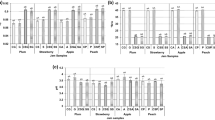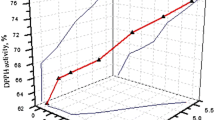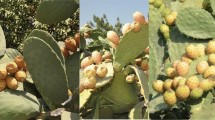Abstract
The use of cactus pear ( Opuntia ficus indica L.) to obtain a new natural liquid sweetener was studied. The juice of the fruit (16.5 ° Brix) was clarified with enzymes, treated with active carbon to take out the color and vacuum concentrated to obtain a 60 °Brix syrup or liquid sweetener. Physical and chemical characteristics determined included: aw; reducing sugars (as inverted sugar); glucose (%); ash content (%); sugar composition by TLC; OD (420 nm) and Y, x, y chromaticity coordinates; viscosity (cps) and density (g ml-1). Sensory analyses to determine the relative sweetness were also conducted. Cactus pear syrup contained 52.38% reducing sugar. The syrup had a pH of 4.31, a viscosity of 27.05 cps, an Aw of 0.83, a density of 1.2900 g ml-1, an acidity (as citric acid) of 0.74% and an ash content of 1.4%. Compared with traditional sweeteners such as fructose and glucose syrup, the acidity was greater than that of HFCS (high fructose corn syrup) of 0.035%, and the ash values were considered a little high compared to glucose syrup which is 1.0%; these disparities can be attributed to the different processing conditions employed. Sensory evaluation revealed the same relative sweetness for cactus pear syrup and glucose, but lower than fructose; cactus pear syrup had a relative sweetness value of 67 with respect to sucrose (100).
Similar content being viewed by others
References
Sáenz C, Arriagada S, Fizsman S, Calvo C (1996) Influence of pH and contents of carrageenan during the storage of cactus pear gels. Acta Horticulturae 438: 131-134.
Sepúlveda E, Sáenz C, Alvarez M (1996) Elaboración de láminas de fruta: Tuna (Opuntia ficus indica(L) Mill) y Membrillo (Cydonia, oblongaMill). CICTA - 5. Textos Completos. La Habana, Cuba: PSM Publicaciones Soporte Magnético.
Sáenz C, Sepúlveda E, Moreno M (1994) Elaboración de cristalizados de nopal. In: Libro de Resumenes VIII Seminario Latinoamericano y del Caribe de Ciencia y Tecnología de Alimentos. Montevideo, Uruguay.
Sáenz C, Sepúlveda E, Moreno M (1995) Estudio de formulaciones para obtención de mermelada de nopal (Opuntia ficus indica). In: Resumenes de temas libres XI Congreso Nacional de Ciencia y Tecnología de Alimentos. Viña del Mar, Chile.
USDA (1997) Sugar and sweetener: Situation and outlook Yearbook. Economic Research Service, December 1997.
Romaní J, De la Barrera S, Zuñiga ME, Ruiz A (1991) Producción de edulcorante líquido con alto contenido en fructosa a partir de descartes de fruta, pp. 83-85, in: Proceedings 9° Congreso Nacional de Ciencia y Tecnología de Alimentos. Santiago, Chile.
Schwartz M, Estévez AM, Toro R (1986) Sucre the raisin: une option technologique face aux excedents the production. Proceedings XIX Congress Internationale de la Vigne et du Vin, Vol. 2: 631-636.
AOAC (1984) Official Methods of Analysis, 14th ed. Wisconsin: Association of Official Analytical Chemists.
Sáenz C, Vásquez M, Trumper S, Fluxá C (1992) Extracción y composición química de mucílago de tuna (Opuntia ficus indica), pp. 93-96, in: Actas 2° Congreso Internacional de tuna y cochinilla. Santiago, Chile.
Wertheim E (1956) Experiments in organic chemistry, 3rd edn. New York: McGraw-Hill.
Panreac (1987) Métodos analíticos en alimentaria. Productos derivados de la uva y similares. Montplet & Esteban, Spain.
Schwartz M, Estévez AM, Alcaíno E, Cabañas M, Araya E (1992) Efecto del pH, concentración y temperatura del azúcar de uva sobre la intensidad de su dulzor. Alimentos 17: 15-21.
Pomeranz Y, Meloan C (1980) Food analysis: Theory and practice, 2nd edn. Westport, CT: AVI Publ.
Ranganna S (1986) Handbook of analysis and quality control for fruit and vegetable products. New Delhi: Tata, McGraw-Hill.
Pedrero D, Pangborn RM (1989) Evaluación sensorial de los alimentos: Métodos analíticos. México: Ed. Alhambra.
Askar A, El-Samahy SK (1981) Chemical composition of prickly pear fruits. Deutsche Lebensmittel - Rundschau 77: 279-281.
Sawaya WN, Katchadourian HA, Safi WM, Al-Hammad HM (1983) Chemical characterization of prickly pear pulp, Opuntia ficus indicaand manufacturing of prickly pear jam. J Food Technol 18: 183-193.
Sepúlveda E, Sáenz C (1990) Chemical and physical characteristics of prickly pear (Opuntia ficus indica) pulp. Revta Agroquim Tecnol Aliment 30: 551-555.
Toro RG (1985) Azúcar de uva cv. Thompson seedless de desecho de exportación: Caracterización química y física del jarabe. Tesis Ing. Agr. Santiago. Universidad de Chile, Facultad de Ciencias Agrarias y Forestales.
Reglamento Sanitario de los Alimentos (1997) Diario Oficial de la Republica de Chile. Res. No 977.
Loyola E (1989) El color en vinos, in: El color en Alimentos: Medidas instrumentales, Ed. by C Sáenz and E Loyola. Santiago, Chile: Public Misc Agrícolas 31: 65-78.
Muller HG (1978) Introducción a la reología de los alimentos. Zaragoza, Spain: Ed. Acribia.
Sáenz C, Costell E (1990) Rheology of prickly pear (Opuntia ficus indica) concentrated juices, in WEL Spiess and H Schubert (eds), Engineering and food, Vol 1: Physical properties and process control, pp. 133-142. Essex, UK: Elsevier Applied Science.
Sáenz C, Costell E (1987) Rheologisches Verhalten von Zitronen-producten. Temperatuor und Konzentrationseinflub. Confructa Studien 31: 114-119.
Castaldo D, Trifiro A, Gherardi S, Zambelli G, Bazzarrini R (1984) Caratterizzazione reologica di puree di mela trattate con enzimi fluidicanti. Ind Conserve 59/2: 109-115.
Garcia R, Rivera J, Rolz C (1974) Rheological properties of some tropical products and their enzymic clarification. Proc. IV Int. Congr Food Sci & Technol, Vol II: 18-26.
Gherardi S, Cataldo D, Trifiro A (1985) Effect of liquefying enzymes on pear purees: relationships between analytical composition and rheological properties. Fleuss Obst. 12: 639-644.
Belitz HD, Grosch W (1988) Química de los Alimentos. Zaragoza, Spain: Ed. Acribia.
Author information
Authors and Affiliations
Rights and permissions
About this article
Cite this article
Sáenz, C., Estévez, A.M., Sepúlveda, E. et al. Cactus pear fruit: A new source for a natural sweetener. Plant Foods Hum Nutr 52, 141–149 (1998). https://doi.org/10.1023/A:1008033704523
Issue Date:
DOI: https://doi.org/10.1023/A:1008033704523




